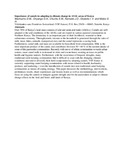Importance of camels in adapting to climate change in ASAL areas of Kenya

View/
Date
2012-04Author
Maloo, SH
Gluecks, IV
Namatsi, JO
Chuchu, SM
Onyango, DA
Machuchu, DM
Language
enMetadata
Show full item recordAbstract
Over 70% of Kenya’s land mass consists of arid and semi-arid lands (ASALs). Camels are well adapted to the arid conditions of the ASALs and are reared in various pastoral communities in Northern Kenya. The dromedary is an important part of their livelihood, essential to their subsistence economy. Throughcamels, income to the household is generated through the sales of milk, meat, hides, animals, transportservices and the camel represents a saving bank. Furthermore, camel milk and meat are available for household food consumption. Milk is the most important product of the camel, and contributes between 50 – 60 % of the nutrient intake of some of the pastoralist communities. Recently with move of ethnic communities towards urban centers, more camel milk is in demand in cities and towns hence creating an issue on public health and hygiene matters. Furthermore with the occurrence of frequent droughts, many traditional cattle keeping communities find it difficult to cope with the changing climatic conditions and tend to diversify their herd composition by adopting camels. VSF-Suisse is
currently supporting camel keeping communities with issues related to health, husbandry, products and marketing – even the introduction of camels into non-traditional camel keeping communities as means of coping strategy. This paper discusses the methodology, interventions, preliminary results, share experiences and lessons learnt as well as recommendations which focus on using the camels to mitigate against drought and for the pastoralists to adapt to climate change effects in the Arid and Semi- arid lands of Kenya
